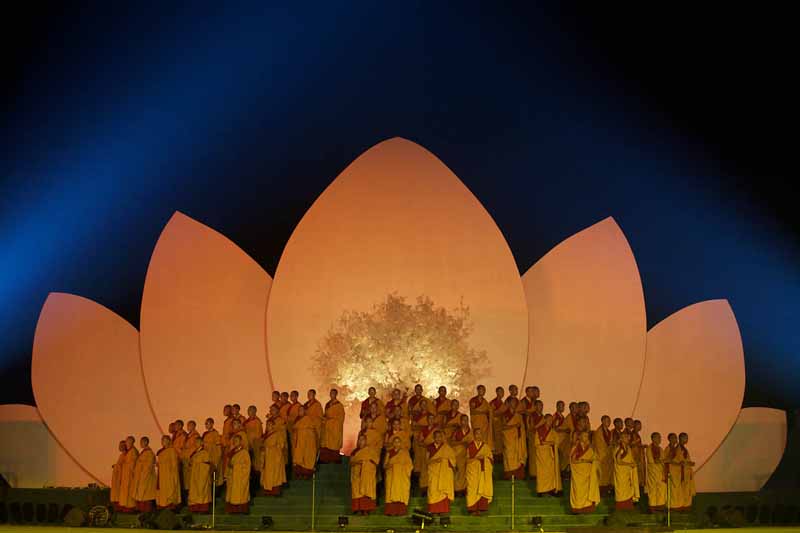法王新闻 | 2010年01月
〈密勒日巴舞台劇〉特別報導
Gyalwang Karmapa’s “Life of Milarepa” Play Performed in Bodhgaya
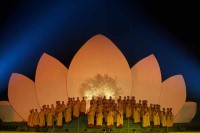
地點:印度菩提迦耶德噶寺旁舞台 Bodhgaya, India
時間:2010年1月1日晚上6:00 January 1, 2010
演出:噶舉僧團、西藏演藝學院(TIPA)
英文报道:kagyuoffice.org
中译:释妙竹
After three years of reading the biography of Milarepa to Kagyu Monlam attendees, two hours at a time, His Holiness transmitted the entire life of Milarepa in a single, magnificent evening. In what was nothing short of a world-class theatrical event, approximately 12,000 people turned out and many viewers were watching live online to view a play of Milarepa’s life created by His Holiness and performed by actors from the Tibetan Institute for the Performing Arts (TIPA). Adding the title of playwright to a list of accomplishments that already seems impossibly diverse, Gyalwang Karmapa himself composed the script for the six-act play. Over the past months, His Holiness has also overseen stage design, rehearsed actors in his temporary residence in Gyuto and generally provided creative direction at all stages of the production. According to TIPA, this was the largest theatrical event in Tibetan history.
噶举祈愿法会连续讲解了三年密勒日巴的传记后,今晚,法王把密勒日巴的整个生平都搬到了舞台上。这场堪称世界级的戏剧盛会,约有 12,000 人参加,许多观众在网上直播观看这场由法王创作,達蘭沙拉的「西藏演藝學院」(TIPA)表演的的大型露天舞台劇。 法王亲自为每幕剧两小时的六幕剧编写了剧本,在过去的几个月里,法王还监督了舞台设计,他在上密院的临时住所里排练演员,并在制作的各个阶段提供创意指导。据TIPA称,这是西藏历史上最大的戏剧活动。

A multi-level stage and massive performance arena were specially constructed under the instruction of His Holiness for the play was constructed as depicting the thousand arms Chenresig. 250 Bhikshu and Bhikshuni on left and another 250 on right portraying 500 eyes and 500 arms on each side making it 1000 eyes and arms of the Chenresig. The 11 steps on the top of the stage depicting 11 faces.
在法王的指导下,专门建造了一个多层次的巨型表演舞台,代表千手千眼观音菩萨。左边的250个比丘和比丘尼,和右边的另外250个,分别代表了500只眼睛和500只手臂,总共构成了观音菩萨的千只眼睛和千条手臂。舞台顶部的 11 个台阶代表菩萨像的11 张面孔。
High-end theatre technology was imported for the event and put to great effect. Even before the performance began, the audience burst into rounds of applause as the stage lighting subtly shifted shades while the audience slowly filtered into the arena. Multiple cameras captured the event for projection on massive screens that flanked the arena, greatly enhancing visibility for the massive crowd.
高端影院技术的引进使得舞台效果显着。在演出开始之前,随着舞台灯光的微妙变化,观众慢慢入场,随即爆发出热烈的掌声。多台摄像机捕捉到了这一过程,并在舞台两侧的大屏幕上进行了投影,大大提高了观众的能见度。
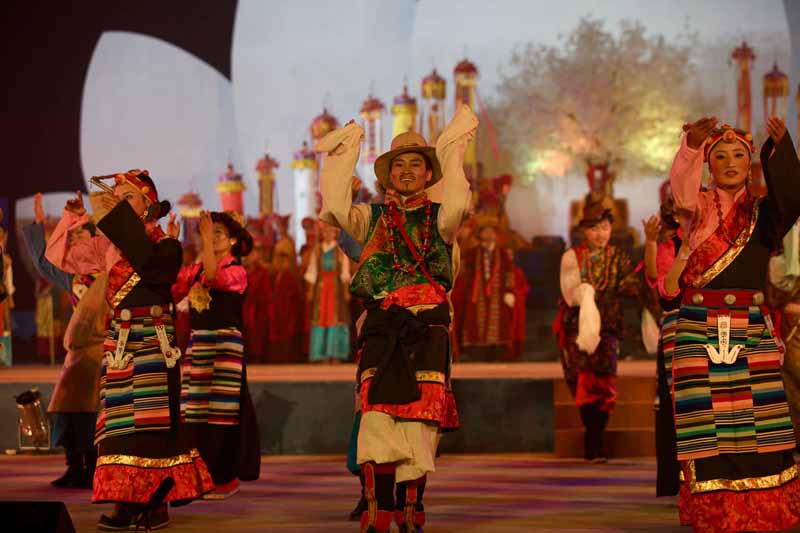
The troupe of over 60 actors and singers traveled from Dharamsala to perform for the event, held on New Year’s day. The play incorporated elements of traditional Tibetan opera into a modern theatrical format, without sacrificing a distinctly Tibetan flavor. In the interludes between acts, Tibetan monks and nuns chanted Buddhist prayers, set mostly to melodies composed by His Holiness. The evening concluded with a rousing series of folk dances from the three regions of Tibet.
由 60 多名演员和歌手组成的剧团从达兰萨拉出发,为这次新年活动表演。该剧将传统藏戏的元素融入现代戏剧形式,同时又蕴含浓郁的藏族风味。在表演之间的插曲中,藏族僧尼跟随法王创作的乐谱唱诵佛经。晚会在来自西藏三个地区的一系列激动人心的民间舞蹈中结束。
Signaling the cultural importance of the play, Kagyu Member of Parliament Sherab Tharchin opened the event mentioning such events were celebrated at the conclusion of Monlam from the times of 7th Karmapa Choedrak Gyatso, and Gyalwang Karmapa himself provided the concluding remarks. Plans for a DVD of the play are already in progress.
噶举派国会议员喜瑞达钦 (Sherab Tharchin) 表示该剧的文化重要性,并在开幕式上提到像这类庆祝始于第七世噶玛巴确扎嘉措时的嘎千活动,而法王本人则致以结束语。该剧的 DVD 版本已经在制作中。
As His Holiness himself pointed out, the performance of life stories of important spiritual figures on New Year’s Day is a deep-rooted Tibetan tradition. While the life of Milarepa has already been captured in numerous works of Tibetan literature, a number of features distinguish His Holiness’ production from other representations of the life of the great Tibetan yogi. On the most basic level, whereas generally a literary Tibetan is most commonly used in theatrical performances, His Holiness created a script in colloquial Tibetan.
正如法王所指出的,新年活动表演重要精神人物的生平事迹是藏族根深蒂固的传统。虽然密勒日巴的生平已经在众多西藏文学作品中得到体现,但法王的作品与其他人描写的这位伟大的西藏瑜伽士的生平有许多不同之处。在最基本的层面上,虽然一般在戏剧表演中最常用的是文学藏语,但法王用口语藏语创作了剧本。
This renders the play far more accessible to a general public, and even for audience members who are highly conversant with literary Tibetan, the shift to a colloquial register of speech allows for a more intimate and immediate encounter with Milarepa as a human being.
这使得普通大众更容易看懂这部剧,甚至对于精通藏文文学的观众来说,口语化的表述也可以更亲密、更直接地体会到身为人的密勒日巴。
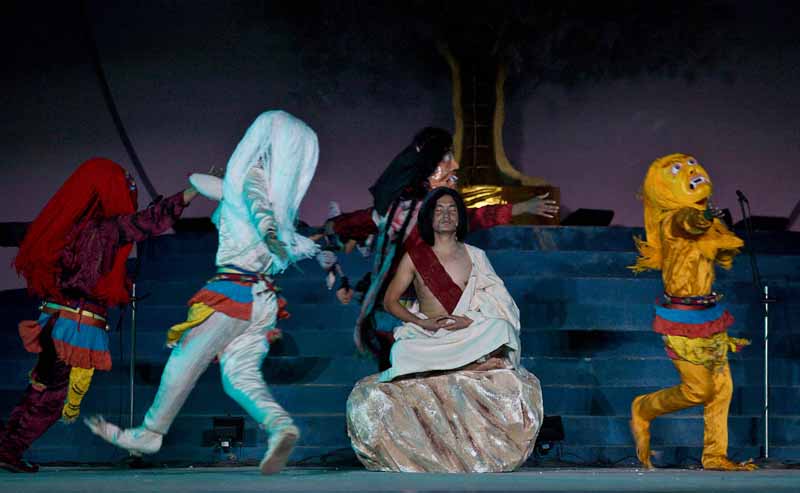
Additionally, His Holiness treatment of the character of Nangasa Kargyen, Milarepa’s mother, reflected great sympathy for her plight as a mother rendered powerless in her efforts to care for her children. With visceral scenes of the physical, verbal and psychological abuse inflicted on her children by their Uncle and Aunt, the drama made clear that Milarepa’s mother had exhausted all other options before charging Milarepa with the task of learning sorcery to bring low their enemies.
此外,法王对密勒日巴的母亲南迦萨卡根的性格的处理反映了对她的困境的极大同情,作为母亲她在照顾孩子上的无能为力。这出剧逼真描绘了姑父、姑母对她孩子的身体、言语和心理虐待的场景,让人深刻体会到密勒日巴的母亲在逼迫密勒日巴学习巫术,来降伏敌人的时已经别无选择。
As she sends Mila off to study sorcery, she tells him, “Other people’s sorcery is the hobby of the rich and pampered. Our sorcery is the last chance of desperate people.”
当她派密勒日巴去学习巫术时,她说,“巫术对别人来说只是富人和闲人的爱好,而对于我们,巫术是绝望的人最后的机会。”
Throughout, His Holiness made full use of the genre of theatre to bring Milarepa’s suffering and spiritual transformation to life, allowing the audience to connect with Milarepa’s in new and vivid ways. When Milarepa returns to his native land hoping to see his mother, he learns instead that she has long since died of a heartbreak, and her neglected corpse was left to rot in their abandoned home. Finding her weathered bones piled in the ruins of the house, Mila falls to his knees and tenderly gathers her bones in his lap. The viewing screens erected throughout the arena were put to great effect during this scene, as a close-up shot of the tears streaming down Mila’s grieving face allowed the audience to share in the depth of Mila’s emotions. At this point, tears were shed by many audience members as well.
自始至终,法王都充分利用戏剧的形式,将密勒日巴的苦难和精神转变成生活,让观众以全新的、生动的方式与密勒日巴的心灵产生共振。当密勒日巴返回家乡渴望见到母亲时,却心碎地发现她早已死去,她的尸体在荒废的家中腐烂,她已风化的骨头散落在房子里。密勒日巴跪倒在地,轻柔地把她的骨头捡起放在自己的腿上。整个会场两边竖立的屏幕在这一幕中发挥了巨大的作用,近距离拍摄了密勒日巴悲伤的脸上流下的泪水,让观众深刻地体会到了密勒此时的情感。此刻,很多观众早已泪流满面。
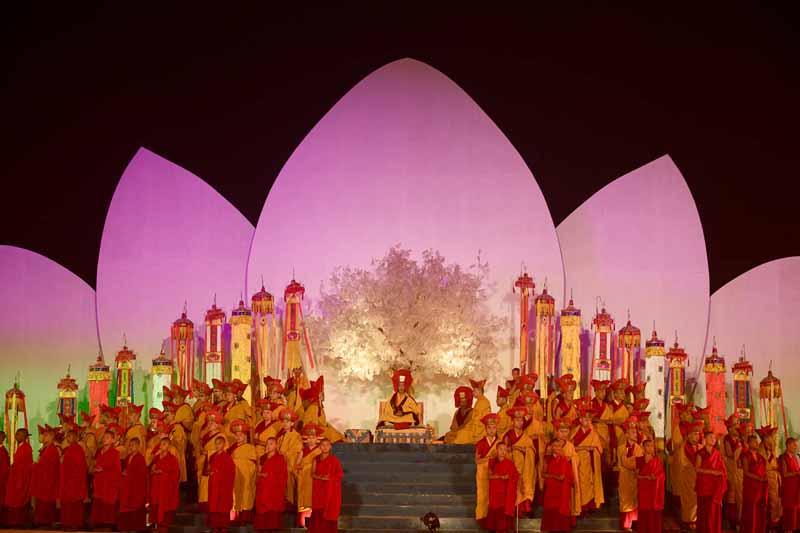
One learned Tibetan geshe commented that while viewing this play he was moved to tears on five separate occasions, including the moment when Milarepa’s mother collapsed in anger when he arrived home drunk from the classes she had arranged in seeking to give him an education.
一位博学的藏族格西评论说,在观看这部戏时,他五次感动落泪,包括密勒日巴的母亲在密勒日巴从她想法设法让他受教育的课堂上喝醉酒回到家时,气得崩溃的那一刻。
Another audience member—not herself a student of the Gyalwang Karmapa—noted that for her the drama brought Milarepa to life more vividly and movingly than any of the films or other performance she had observed thus far.
一位并不是法王弟子的观众说,对她而言,这部戏剧比她迄今为止看过的所有电影或其他表演更生动地再现了密勒日巴。
The drama offered moments of comic relief as well, much appreciated by the audience. When Milarepa introduces himself to Marpa as “a great evildoer from Lato,” Marpa replies: “Maybe you are a great evildoer. But why are you bragging to me about it? I’m not the one who made you commit evil deeds. What evils have you done, anyway?” prompting bursts of laughter from the audience.
该剧还提供了喜剧性的缓解时刻,深受观众欢迎。当密勒日巴向马尔巴介绍自己是“来自拉拓的大恶人”时,马尔巴回答说:“也许你是一个大恶人。但是你为什么要跟我吹嘘呢?让你作恶的又不是我。你到底做了什么坏事?”引得观众阵阵笑声。

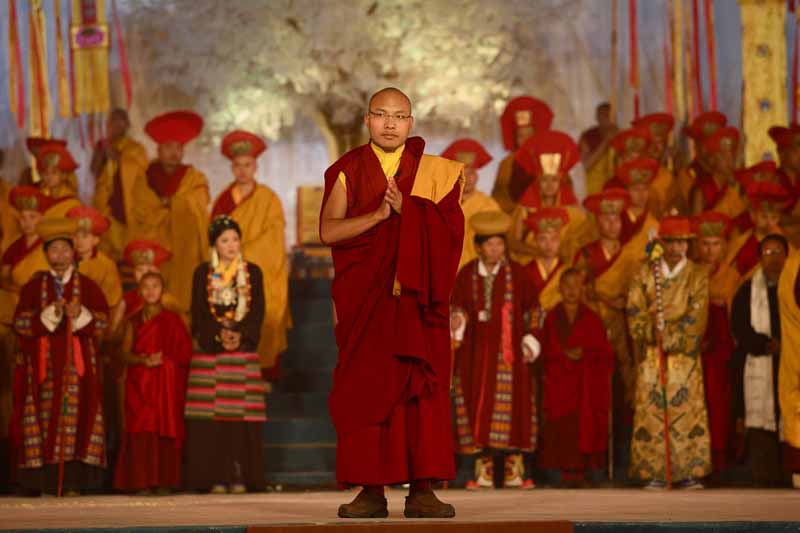
A winter chill further heightened the realism and contributed to the intensity of audience involvement in the performance as well: As temperatures dropped steadily during the evening, the character of Milarepa appeared on the windswept stage, clad in scene after scene in a thin white cloth, as audience members huddled together shivering in their jackets and wool shawls. Viewers were left to reflect on the contrast between Milarepa’s unflinching mountaintop asceticism and their own responses to the relatively mild cold of the Bodhgaya night. Meanwhile, the 500 bhikshus and bhikshunis seated to either side of the stage continued to watch intently with right arms bared and shaved heads exposed to the night air.
冬天的寒意进一步增强了真实感,也增加了观众对表演的参与度:随着夜晚的气温逐步下降,密勒日巴的角色出现在狂风大作的舞台上,一幕一幕披着薄薄的白布,当观众挤在一起,穿着夹克和羊毛披肩瑟瑟发抖,不得不对密勒日巴在山顶坚定不移地苦行与他们在菩提迦耶寒冷夜晚中的反应做对比。与此同时,坐在舞台两侧的500名比丘和比丘尼在夜色中裸露着光头和右臂继续专注地观看。
During his concluding comments, His Holiness gazed out upon the many thousands of audience members for a moment, and then commented that the benefits of having heard Mila’s life story include protection from rebirth in the lower realms and liberation. Gyalwang Karmapa expressed how happy he was that everyone had come to the play, and with great generosity, thanked the audience for their forbearance of the cold.
在结束语中,法王凝视了成千上万的听众片刻,说,听到密勒日巴的生平故事的好处包括来生不入恶趣和解脱。法王表示很高兴大家都来观看演出,并以极大的热诚感谢观众们对寒冷的忍耐。
